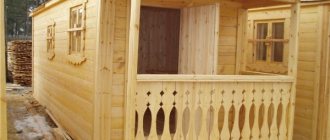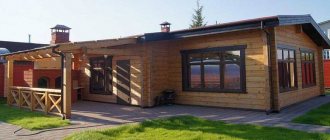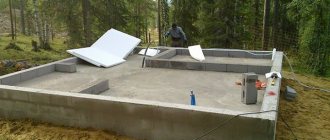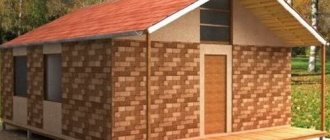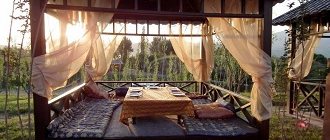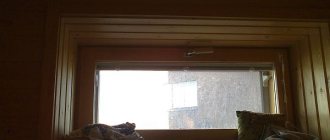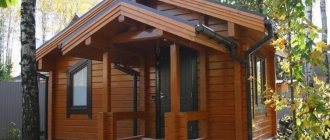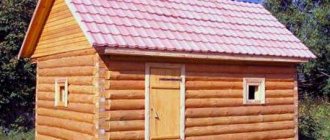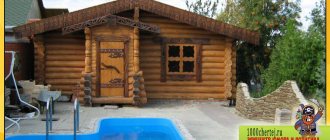Probably every summer resident dreams of having his own bathhouse in his country house. But really, it's worth it! No other holiday can compare with a relaxing break in a bathhouse after active, hard or even dusty work in the garden. There are different types of baths, and before building a bath you need to decide which type of bath will best fulfill its role?
As you know, baths are distinguished by temperature and moisture. The hottest, but at the same time the driest, is the Finnish sauna.
, in which the temperature reaches up to
140
degrees, and only about
15
% moisture is recorded.
The Russian bathhouse
seems to have a “golden mean”, in contrast to the hot Finnish and humid Turkish ones.
The temperature in it reaches 60-80
degrees, with a humidity
of 30-45
%.
But in a Turkish bath
you will immediately feel greater humidity, since there it is about
100
%, while the temperature reaches only
50
degrees. But this does not mean that you won’t sweat in a Turkish bath; the moisture transmits temperature very well.
A little about the design of the bathhouse.
For anyone who has built a dacha, building a bathhouse will seem like a nonsense matter.
Moreover, you need to build it with joy and anticipation of receiving the joy of steaming in a bathhouse. Of course, first of all, you need to choose the optimal place for the bathhouse (more on this below), so that it fits into the overall style of the garden, so that it does not interfere or block the view of the garden or flower garden. Before building a bathhouse, think and calculate the material you need, because if you want to use it only in the summer, then you don’t need to insulate it so much. Using my own example, I will say that the size of a bathhouse for one or two people may well vary from 30 square meters, taking into account the fact that the insulation of the bathhouse for winter use will take up enough space. The bathhouse is usually divided into three parts and consists of a dressing room, where you can also put a table and benches. Next we pass the washing room (dressing room), where you can wash yourself before taking a steam bath, and in the summer it can also be an ordinary shower room. And the very heart of the bathhouse is the steam room (or sauna). These three rooms should have one window each (3 in total), but they are small in size so that heat does not escape through them. There are also 3 doors that must open outward for safety reasons. Interesting moment! Doors in the bathhouse should be made almost entirely of wood, durable polymer or heat-resistant glass. If you install an ordinary door with an iron handle, then you will not be happy))) Iron in the bathhouse gets very hot and can seriously burn you! Therefore, first of all, I will warn you against troubles and advise you what I bought myself. It is better to buy doors for a bathhouse in an online store
, which has long proven itself in the sales market. It doesn’t matter what kind of doors the material is, I personally liked the ones made of glass with a pattern about nature. I took a steam bath and really felt refreshed, because there was a pleasant, fresh atmosphere around me - a drawing of nature, fragrant brooms, aromatic oils!
What do we build a bathhouse (sauna) from?
The materials are all simple, roughly speaking, accessible. The construction of a bathhouse begins with the foundation. It happens: - strip foundation. Monolithic or block. This is the simplest and most common type of foundation for small buildings; - columnar foundation. Or support-columnar (see photo below). For dense soil. The pillars are installed at the corners of the building and at the junction of internal walls;
- screw foundation. It should be used if you have moving, soft soils or a slope. — pile-grillage foundation. The piles must be screwed into the ground using levers and then filled with concrete. This strong type of foundation is used in areas with quicksand. Yes, there have been cases when an unstable building simply “floated away,” but it’s better to “Measure seven times, cut once.”
Let's move on to the walls. It is better to build them from pine timber, 100x100 mm in size. We quickly and economically decorate the inside of the bathhouse with wooden clapboard. We cover the roof with slate; of course, ondulin will look more beautiful, matching the color of the roofs of other buildings and structures. We make the ceiling from boards (then we also cover it with clapboard). We insulate the attic with a solution of clay and straw. We lay planed wooden boards on the floor (but first insulate it!). Everything else is small - windows, doors, walls, barrels and buckets, and all the other internal utensils.
How to insulate a bathhouse (sauna).
After the main construction of the bathhouse, we carefully insulate it. Basalt wool is excellent for this. First of all, they insulate the ceiling, then move on to the walls. The floor should already be insulated; we place the cotton wool in advance in front of the floorboards. Next, we cover the insulation with a layer of vapor barrier, onto which, so as not to fall off, we immediately nail wooden slats. You need to attach rolled foil to the slats themselves, and glue the joints with metal tape. Left a little! We trim the ceiling and walls with wooden paneling made from linden or aspen; it is believed that this is the best wood for a bathhouse. Well, the bathhouse is ready!
And now, in the end, I’ll tell you which place on the site to choose for building a bathhouse.
It is important. The best place for a bathhouse is the far corner of your dacha or garden plot. Since the bathhouse has a certain percentage of fire hazard (this depends on the care of the bathhouse), it is better to locate it away from the country house. It happens that a bathhouse was built far from the house, but literally 5 meters away in the garden there was a pile of hay that was not used quickly. That won't do either. But also expect that the utility block is not far from the bathhouse, there may be a firewood shed and water supply...
Plants near the bathhouse.
Since the bathhouse is being built on a garden plot, how can you do without flowers! Do you know what are the best trees, bushes, herbs and flowers to plant near the bathhouse??? Well, of course, fragrant and medicinal! From the trees, plant several birches, they have medicinal buds and young leaves. One is sticky, its color makes excellent bath teas. Juniper can fill a bathhouse with a magical aroma; its branches, emitting medicinal phytoncides, will not only decorate the steam room, but will also drive out any infection from you! And near the very entrance to the bathhouse, plant a flower garden: mint, oregano, thyme, St. John's wort, chamomile, sage and coltsfoot. These plants are the most recommended for preparing infusions and teas taken in the bath. Well, or you can imagine a flower garden like the one shown above in the picture, where there are no less fragrant herbs. Enjoy Your Bath!!!)))
The presence of a personal plot opens up wide opportunities for the implementation of different ideas. In a beautiful frame the main thing will look impressive. The territory can be marked for recreation and recreation for adults. Qualified landscaping of the territory of a private house will help increase the level of comfort and successfully solve a number of practical problems.
Read in the article
Landscaping garden plot
It is easier to design a site from scratch when the area retains the pristine purity of nature. Having a home is not a problem in most cases. But the lived-in space can also be transformed; the main thing is to develop a clear concept. Therefore, landscape design always begins with planning, which includes the following stages:
- A diagram of the site is drawn on a sheet of paper, conveying its shape and size in scale.
- Existing structures (house, garage, bathhouse, outbuildings) are drawn.
- Areas that are planned to be developed for various needs (greenhouse, playground, recreation area or swimming pool) are marked.
Comment! If the area is small, you should set priorities in advance.
A clutter of buildings and decorative elements does not contribute to the formation of a harmonious landscape design.
- The scheme must contain all significant perennial plantings, after which it is supplemented with new elements.
- Markings with communications facilitate the proper placement of new objects. This is especially true for bathhouses and greenhouses, the operation of which will require the presence of light, water and, in some cases, gas.
- Comfortable spending time in a suburban area is impossible without designing paths. According to the rules of landscape design, they must connect all buildings and have a single style solution.
- Flower beds always remain the bright notes of design. The diversity of flower bed shapes will allow you to choose the most suitable type for a particular site.
When drawing up a landscape design plan, it is advisable to have information about the characteristics of the soil and groundwater level. This also matters when planting flower beds, building a bathhouse or arranging a garage.
The first step is to start directly from the area used for planting vegetables and fruits. In addition, a summer cottage plot is an excellent opportunity to try yourself as a landscape designer.
To begin, draw up a plan of your summer cottage on paper. Start from exactly how the house is located. It is important to note which and where buildings already exist. Also think carefully about what you would like or simply lack to fully relax. Perhaps you would like to admire a pond with small fish, do you have a gazebo, or do you still need to improve such a structure. Maybe you love strawberries, so think about where it would be convenient for you to pick them. And in general, everything your soul desires!
If you are creating a landscape design with your own hands, be patient and knowledgeable in numerous areas, as well as effort. With all this, you should always remember what you initially wanted to see on your own site. After all, in fact, in the process of creating a design it can very easily happen that the main idea is simply lost. As a result, you may end up not with a garden, but with a collection of beds, from which it all originally began.
Path design
The layout of the paths should be based on which garden areas need access. A very good solution would be to lay out the so-called excursion route directly past the most attractive places in the garden. If the appearance of your flower beds and beds is preserved, be sure to consider making the path to them, as well as the beds, as simple as possible.
As for the walking route among the bushes and trees, it can be winding and quite difficult. This way you will allow each of your guests to enjoy all the delights of your site.
Yes, in fact, not everyone has as much free space in their dacha as they would like. But at the same time, the width of the tracks should not suffer at all. Take into account that two people can safely walk on it in the event of a situation. The most optimal width of paths is considered to be up to one and a half meters.
Also, garden paths should have a slope, at least slightly, so that puddles after precipitation do not linger on them. At the same time, such water will additionally water, moisten the plants planted nearby, and once again wash the paths from dust and dirt.
As for the materials used for garden paths, it must be as resistant to temperature changes and various weather conditions as possible. As a rule, stone, concrete, and decorative tiles are used for these purposes. The most natural option is paths sprinkled with gravel or sand. Pebble paths lined with mosaics are also attractive.
When choosing tall plants, place them in the north direction. Shrubs should be identified in the middle zone of the site. But tomatoes with lettuce peppers should be planted in the south of the garden.
Trees with flowers should be positioned as naturally as possible. At the same time, it is worth paying attention to the relief on the site, for example, there is no need to level out the hillocks in the areas; play with it by creating your own, unique design.
We borrow good experience - a patio and an artificial pond.
Construction of a bathhouse
Construction of a bathhouse
Close Send
This style is more common in America, but since it is quite convenient and thoughtful, it’s worth borrowing. Patio
this is a large terrace that starts near the house or bathhouse and leads to a pool or artificial pond. The convenience of such a structure is obvious: after the procedures in the steam room, you can go and enjoy the refreshing coolness of the water, without fear of getting your feet dirty, and bringing dirt into the pool or bathhouse. For convenience, you can modify this style. Place the pool where it is convenient for you and lay a narrow path to it.
Making a pool is not at all difficult:
- Buy a ready-made version of the pool in the store.
- Prepare a pit for it and install a bowl.
- Equip all the necessary systems: water supply, electricity.
- Fill the pool with water and cover it with film after use to protect it from precipitation and debris.
More detailed information about the technology for arranging a swimming pool can be found in
If you have the opportunity and desire, you can make a full-fledged swimming pool with a canopy made of polycarbonate slabs. A place for swimming near the bathhouse will make your visit to the steam room more useful and enjoyable.
Accommodation
The best options are a colorful flower garden near the gate or along the fence. This design will transform the overall exterior and attract the attention of guests. Experts recommend using delphinium, a tall perennial plant with about 450 species in a variety of colors. You can complement the composition with viburnum or cherries.
Login registration
The entrance to the local area creates the first impression. A colorful flower garden near the gate indicates that the house is inhabited by good-natured owners with excellent taste.
https://www.youtube.com/watch?v=ibE4aDo2HG4
To decorate a flower garden in the initial location, near a private house or cottage, use the following plants:
- Petunia. Miniature colorful flowers with a pronounced aroma.
- Rose. Queen of the flower world, you can choose varieties in the form of shrubs or climbing plants to decorate high gates and fences.
- Thuja. An evergreen cone-shaped plant in a rich green color.
- Lily. A delicate and romantic flower of various shades - from snow-white to bright and dark options.
- Sage. Medicinal herb with bright purple inflorescences.
- Clematis. A climbing plant covered with bright flowers.
- Cuff. Herbaceous plant with wide leaves and small yellow-green inflorescences
- Virginia. A variety of tobacco with wide leaves of light green color.
- Sedum. The plant has many species. The most popular is a shrub with lush bright pink inflorescences.
- Chistets woolly. The leaves of the plant are covered with small and soft hairs of a silvery color.
- Balsam. A low-growing flowering plant, which is decorated with large and bright buds.
- Veronica (garden). Herbaceous plant with small blue flowers.
We divide the flower garden into sections:
- In order for the living composition near the entrance to look beautiful, it is necessary to divide it into certain locations according to the type of plants.
- For tall and large flowers, a separate area of one meter is allocated. We plant no more than three plants in this zone.
- About 5-6 medium sizes are needed to fill an area of about 70-80 cm.
- Planting of low-growing plants in the amount of 8-10 units is carried out at a location of 30 cm.
- If you are using dwarf plants, you can plant 20 of them on an area of 17 cm.
An ordinary path can become a colorful and expressive decoration of any garden or yard. Before starting work, you need to dig up the area along the path and then remove the top turf layer. Next, you need to fill the resulting recesses with soil prepared in advance, suitable for specific plants.
Login registration
The entrance to the local area creates the first impression. A colorful flower garden near the gate indicates that the house is inhabited by good-natured owners with excellent taste.
To decorate a flower garden in the initial location, near a private house or cottage, use the following plants:
- Petunia. Miniature colorful flowers with a pronounced aroma.
- Rose. Queen of the flower world, you can choose varieties in the form of shrubs or climbing plants to decorate high gates and fences.
- Thuja. An evergreen cone-shaped plant in a rich green color.
- Lily. A delicate and romantic flower of various shades - from snow-white to bright and dark options.
We divide the flower garden into sections:
- In order for the living composition near the entrance to look beautiful, it is necessary to divide it into certain locations according to the type of plants.
- For tall and large flowers, a separate area of one meter is allocated. We plant no more than three plants in this zone.
- About 5-6 medium sizes are needed to fill an area of about 70-80 cm.
- Planting of low-growing plants in the amount of 8-10 units is carried out at a location of 30 cm.
- If you are using dwarf plants, you can plant 20 of them on an area of 17 cm.
Features of choosing a place for a bath
A country vacation cannot be considered complete if there is no bathhouse on the site. When choosing or drawing up a project, they are guided by the size of the site, the planned financial costs and strive for compatibility of style with a residential building. It is very important to find a suitable place on the site for a bathhouse. Rest is invariably associated with a peaceful atmosphere, and it is advisable not to disturb your neighbors. Based on the following recommendations, it will be easier to choose a suitable area for a bathhouse:
- Despite the apparent convenience of being near a body of water, the bathhouse should be located at a distance. This will avoid erosion of the foundation and the negative consequences of floods. An exception may be a bathhouse on a hilly area, and then only after careful geological exploration.
- It is unwise to place a bathhouse near a road; dust and noise can disturb any atmosphere; even expensive room design will not help.
- A bathhouse with high-quality ventilation and a well-thought-out sewerage system will protect the area from sewage pollution and unpleasant odor.
- It is preferable to place the bathhouse on the south side of the site, so the structure will be protected from the wind and have better lighting. A door with access to the south will save the strength of the site owners in winter, when the need arises to clear snowdrifts.
- It is recommended to plan the bathhouse windows facing west. Evening relaxation and admiring the sunset - what could be more romantic?
- A bathhouse near a neighbor's property is contrary to building codes. A bathhouse located among trees will allow you to achieve organicity in landscape design.
- If the material for constructing a bathhouse is wood, it is better to install the building, which is unsafe from a fire point of view, away from the house.
- A gap of at least 15-20 m between structures will help prevent contamination of the source of drinking water by drains from the bathhouse.
In addition to the correctly selected site, the external design of the bathhouse plays a significant role. It is desirable that the walls of the house and the bathhouse are made of the same material. This is especially true for landscape design if the building is in plain sight. The exterior of a bathhouse hidden in the thick of green spaces is less important. But it is better to choose a roofing material similar to the main building. This contributes to a harmonious perception of the design of the site as a whole.
Optimal blind area sizes
SNiPs do not have specific overall dimensions for the blind area. But builders clearly know how wide this element of the house should be. Its width depends on the length of the building's roof overhang. For example, if the roof overhang, which is the distance from the wall of the house to the edges of the roofing material, is 40 cm, then the width of the blind area should be at least 60 cm. That is, at least 20 cm more.

Width of the blind area around the house Source cf.ppt-online.org
The essence of this relationship is that precipitation from the roof falls onto the blind area. And this regardless of whether a drainage system is installed. Because a walkway installed flush with the roof eaves or closer to the wall will not be able to effectively drain water from the foundation. In addition, the further the water falls from the latter, the better. That is why most often the width of the blind area is chosen within 1 m. The size of such a path is also more convenient in terms of moving along it.
Although there are other requirements regarding this size:
- on strong soils, the width of the blind area can be within 80 cm;
- on weak ones, which are usually prone to frost heaving, at least 90 cm.
As for the thickness of this building element, there are certain requirements. Firstly, it should be noted that the path laid around the house is a multi-layered element. And more often it consists of three layers:
- sand 30 cm thick minimum;
- crushed stone of the same size;
- concrete mortar as the outer layer.
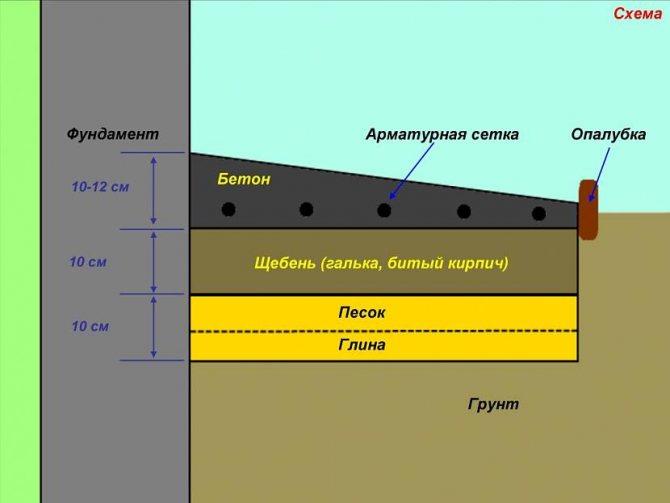
Today, many private developers use insulated blind areas around their own home. This is done for one sole purpose - to insulate the foundation of the house. For this, the following materials are used: expanded clay, perlite or polystyrene foam boards. The thickness of the thermal insulation layer depends on the chosen material, but most often does not exceed 10 cm.
If you decide to decorate the blind area, for example, with stone or paving slabs, then when forming the trench you will have to take into account the thickness of this material. It can be laid on a prepared sand-crushed stone bed using a concrete mixture, or, by first pouring a concrete base, it can be laid on it. In any case, there is only one requirement for such a design - to seal the seams between the decorative elements so that water does not penetrate through them into the ground, and, accordingly, to the foundation.
And one more point regarding the thickness of the sand layer. Firstly, this size must be maintained taking into account the compaction of the building material. Secondly, it is 30 cm that creates a barrier to the vertical capillary rise of moisture. That is, moisture from the ground can rise upward only 30 cm, not higher. This means that all other layers will be well protected from below.
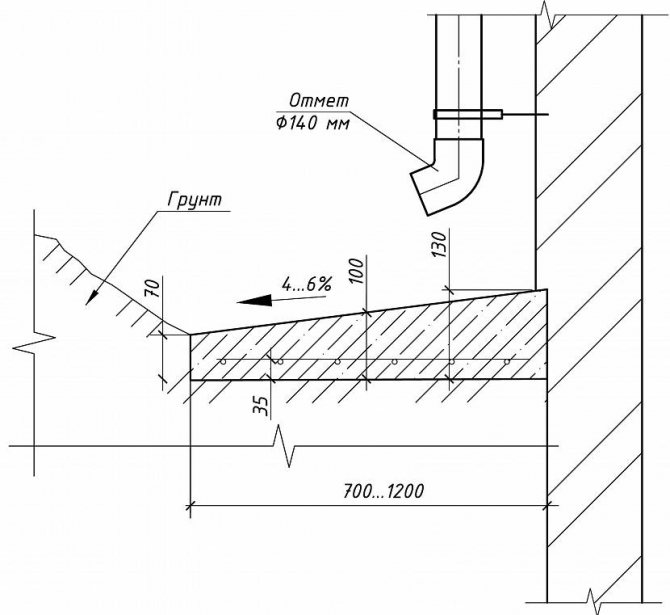
Slope of the blind area from the wall Source cokr54.ru
And the last dimension of the track is the slope. It is clear that water falling on the blind area must be drained away from the house. Therefore, this building element is formed with a slope from the wall. This parameter depends on what material the track will be constructed from.
- If concrete or asphalt is used as a coating, the angle of inclination varies in the range of 3-5°.
- If it is decided to finish the path with paving slabs, stone or other building material, then the slope must be at least 5°.
These are the minimum values. Large ones can be allowed.
Decor “Sunny Flowerbed”
Experts often use a technique called a “sunny flowerbed” in landscape design. The flower bed is placed in a bright place. Natural lighting will make the colors more expressive.
The following types are perfect for arrangement:
- Hibiscus. Flowers with large and colorful buds of different tones.
- Juniper. Evergreen plant with blue berries.
- Kufeya. A shrub with small flowers of various shapes and colors.
- Helenium. The flowers resemble daisies in appearance, but have a rich color
- Petunia. We talked about this charming representative of the flora earlier in the article.
- Vatochnik. They are characterized by bright and small inflorescences.
- Penstemon. Tall and elongated plants, the flowers are bell-shaped.
Experts often use a technique called a “sunny flowerbed” in landscape design. The flower bed is placed in a bright place. Natural lighting will make the colors more expressive.
The following types are perfect for arrangement:
- Hibiscus. Flowers with large and colorful buds of different tones.
- Juniper. Evergreen plant with blue berries.
- Kufeya. A shrub with small flowers of various shapes and colors.
- Helenium. The flowers resemble daisies in appearance, but have a rich color
- Petunia. We talked about this charming representative of the flora earlier in the article.
- Vatochnik. They are characterized by bright and small inflorescences.
- Penstemon. Tall and elongated plants, the flowers are bell-shaped.
Paths and lawns
The attractive design of the site is formed by the combination of garden paths and lawns. There are many variations of arrangement, let's start with the forms. Some people like clear geometry, others prefer to bring landscape design as close as possible to the natural manifestations of nature and design winding paths. The material for the arrangement is selected taking into account the general style of the site:
- Massive or graceful stone buildings need to be supplemented with stone or pebble paths.
- Adherents of the rustic style and owners of log houses should take a closer look at the option of laying paths from wooden saw cuts.
- Clinker bricks or paving stones are another option for designing paths in landscape design.
- An area with combined paths looks original when the middle is filled with large stone slabs and the edges are decorated with small pebbles.
The origin of the lawn on the site is also different. Availability of funds allows you to supplement the landscape design with lawn delivered in rolls. In this case, the ideal appearance is guaranteed. You can save money by planting lawn grass yourself. The process is lengthy, and you can achieve an impeccable appearance of your landscape design if you periodically reseed bald spots and regularly care for the area.
Types of garden paths
Paths and paths in a summer cottage are made from different materials. Almost all known materials used in construction and decoration can be used. Let's look at the most popular options.
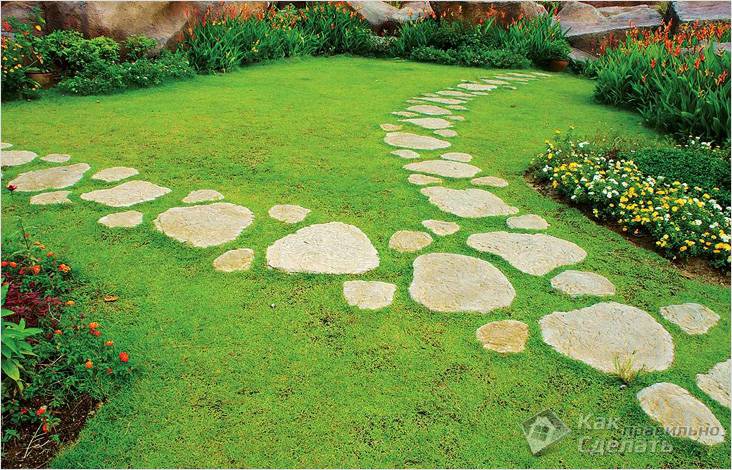
Made from natural stone
A natural stone. The main differences are natural beauty and nobility. It is worth noting the high strength, which is, of course, a plus, and the high cost, which is disappointing. Using this material, you can lay out a curved path, since stone elements arranged in a chaotic manner easily form smooth bends.
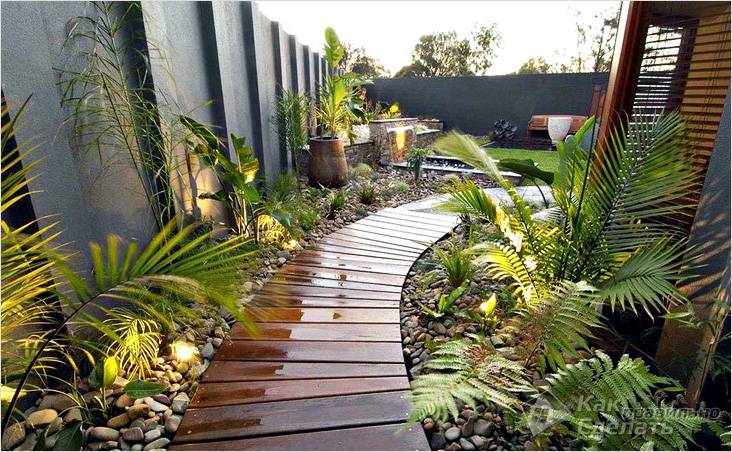
Wooden
Tree. If the landscape design is made in a rustic Provence or country style, then wood is also suitable for decoration. To preserve the material, it is recommended to use special impregnations and varnishes.
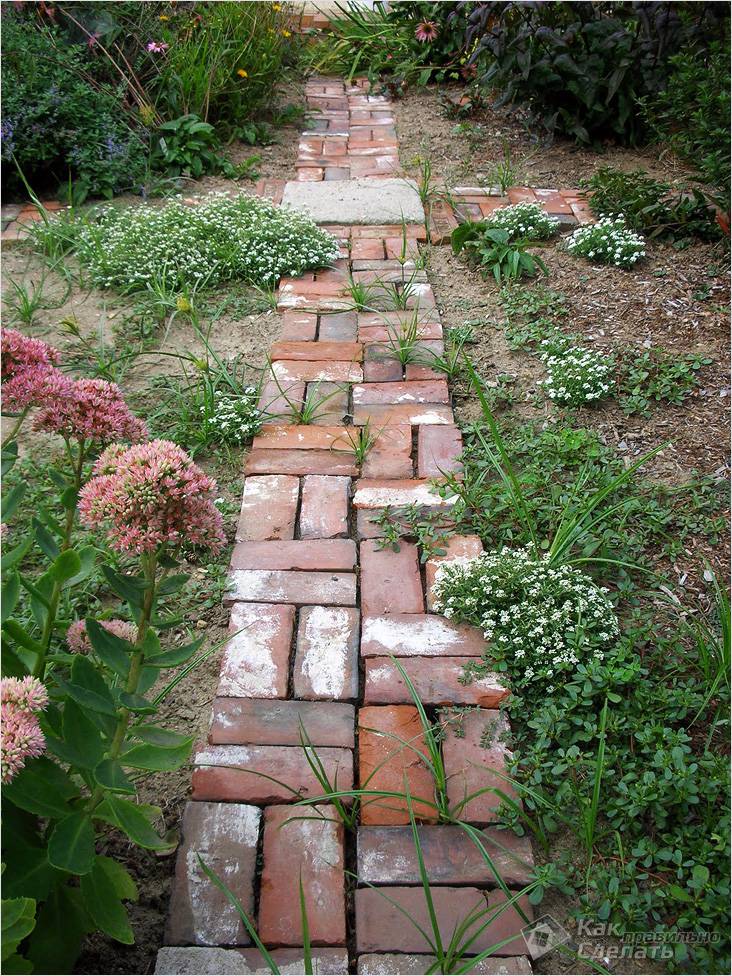
Simple brick path
Brick. A common material for the construction of houses and outbuildings. But it is also suitable for building paths in summer cottages. Ordinary brick has an unattractive appearance, so it is better to give preference to special types that look aesthetically pleasing and are not afraid of moisture and low temperatures.
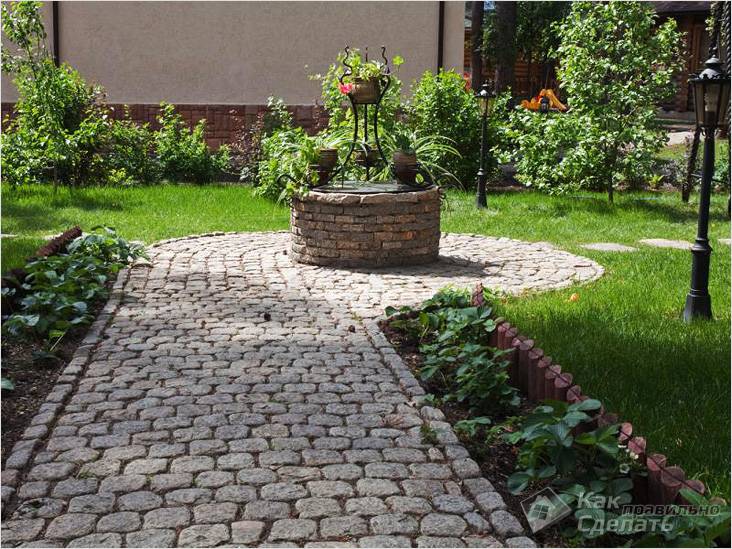
Paving stones
Paving stones and paving slabs. Thanks to the large assortment and variety of colors of paving slabs, you can lay out a path according to a pattern in order to obtain a specific pattern or ornament as a result.
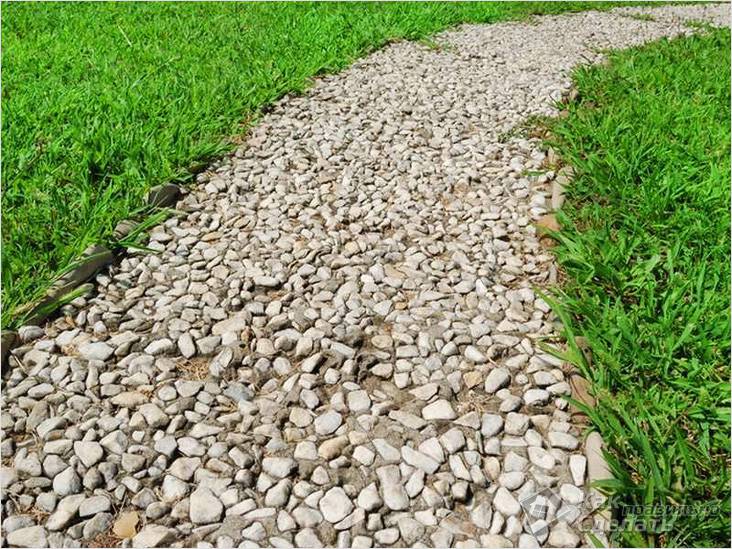
Gravel
Gravel. A budget option. If installed correctly, the path will last a long time. In addition, gravel will look good in the far corner of the garden or near an artificial pond.
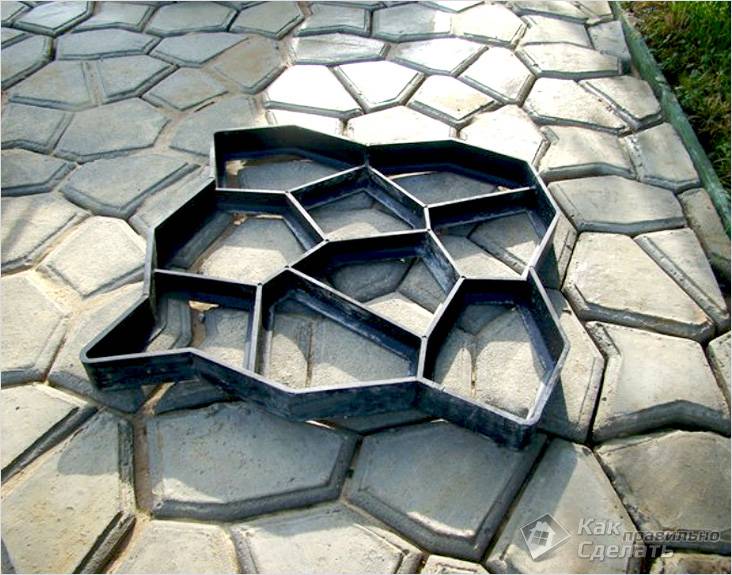
Mold for concrete path
Concrete. An original concrete path can be made using special forms. They are made of plastic and are sold in hardware stores. You can make them yourself after first familiarizing yourself with the technology.
To achieve a stylistic match between the paths and the surrounding natural and artificial objects, it is recommended to use a combination of materials and installation techniques. For example, use stone and colored gravel, wood and pebbles, brick and concrete.
If you want to use color schemes, you should be careful: the selected pattern must harmoniously fit into the landscape design being created and be suitable in style.
Composition near the bench
The “Rainbow Bench” technique is the design of a flower bed near a bench or bench. This design will create a cozy area for rest and relaxation on the territory of the land plot. In this case, the following plants are used:
- Fern. A perennial plant of dark green color with leaves of an original shape.
- Mouse hyacinth. A low plant decorated with inflorescences of bright miniature flowers.
- Lemon verbena. Narrow green leaves on thin stems.
- Malvaviscus. The plant attracts attention with scarlet flowers.
- Horny goat weed. The unusual shape of the buds and attractive color make Horny goat weed popular in the field of exterior decoration.
The “Rainbow Bench” technique is the design of a flower bed near a bench or bench. This design will create a cozy area for rest and relaxation on the territory of the land plot. In this case, the following plants are used:
- Fern. A perennial plant of dark green color with leaves of an original shape.
- Mouse hyacinth. A low plant decorated with inflorescences of bright miniature flowers.
- Lemon verbena. Narrow green leaves on thin stems.
- Malvaviscus. The plant attracts attention with scarlet flowers.
- Horny goat weed. The unusual shape of the buds and attractive color make Horny goat weed popular in the field of exterior decoration.
Layout of flower beds and flower beds
The use of available materials when decorating flower beds on a site is one of the most popular landscape design techniques. Bicycle, barrel, tires, cart - it is not possible to list all the options. The imagination of the site owner can exceed all expectations.
A compact area is not a limitation for planting flower beds. In this case, the design moves from the horizontal to the vertical plane. Various hanging pots and boxes, multi-tiered flower beds and wall panels - there are many ways to beautifully decorate a space without taking up free space.
What are ready-made baths?
Their whole essence is already in the name - these are baths made of timber and assembled directly at the factory, which are completely ready for use. Thus, the installation of a transportable bathhouse does not require a whole team of builders to travel to your site and can be carried out on almost any landscape - it is simply placed by a crane in a precisely designated place. It is this circumstance that makes them incredibly convenient for people who want to place a bathhouse in an already landscaped space - there is no need to cut down carefully selected trees, replant your favorite petunias or demolish greenhouses
. And since most ready-made baths are equipped with a pre-installed wood-burning stove, you can use it immediately after installation. In addition, if you realize that you do not need a bathhouse, then, since the bathhouse is delivered ready-made, it is as easy to get rid of it as it is to install it: the same crane that installed it can easily take it away Your site without any damage.
Additional element
Live butterflies will add charm to your flowerbed. Insects pay attention to the buds of plants that attract their attention with color and aroma: purple echinacea, chamomile, sage, thuja, zinnia (popularly called majors).
If you decide to give the flower garden a round shape, consider the color of the flowers, their shape and height when creating the composition.
Live butterflies will add charm to your flowerbed. Insects pay attention to the buds of plants that attract their attention with color and aroma: purple echinacea, chamomile, sage, thuja, zinnia (popularly called majors).
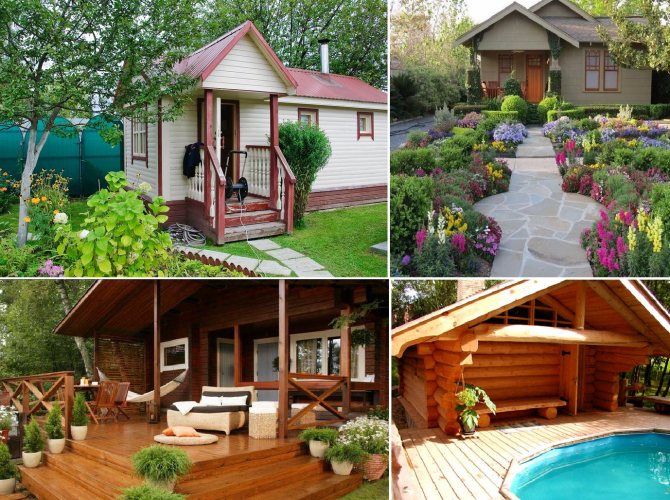
If you decide to give the flower garden a round shape, consider the color of the flowers, their shape and height when creating the composition.
Decorative items in and outside the bath
The area of the pond and near the building with the steam room can be decorated with decorative lamps using alternative energy (solar batteries), in the form of animals, insects and mythological creatures. For flowers, many available means can be used as a container. Do not throw away old buckets, watering cans, troughs and even wooden tubs. They plant:
In this way, you can create a real mixborder from plants that cannot live in the same soil.
A wooden well will become an amazing and truly colorful decorative object. It doesn't have to be real and functioning. It is enough to build its outer part, as similar as possible to the original. Near the bathhouse, this element will look very natural and organic. As if they were about to come out of the steam room for a bucket of ice water. The place near the well is decorated with flowers and shrubs (lilac, raspberries, grapes). The well should have a small roof, decorated with carvings and wooden plant elements (leaves, flowers, bunches). A wooden bucket by the well will complete the look.
Arrangement of recreation areas
Another standard placement of flower arrangements is next to the recreation areas in the yard (gazebos, open verandas and much more). These elements in the local area will become much more attractive and beautiful after placing flower beds nearby.
In the warm season, a gazebo is the best place for a comfortable time in nature. The best option for creating a flower garden: divide the overall composition into separate squares and plant plants in them. Experts strongly recommend not choosing more than six colors for decoration.
The following options are ideal:
- Sage. The plant will especially appeal to lovers of purple and its shades. You can also buy a variety with white and blue flowers.
- Sedum. Different varieties look significantly different from each other. Choose any one.
- Coreopsis. An unpretentious plant with bright flowers. The most popular types are yellow or burgundy.
- Mock orange (jasmine). This species attracts attention with snow-white flowers located close to each other and a charming aroma. May take the form of a bush or small tree.
- Clematis. Climbing flowers of amazing beauty.
Territory for the little ones - we are setting up a playground.
In the process of building a bathhouse and beautifying the area near it, many forget to take care of the smallest, but nevertheless the noisiest “destroyers” - children. If you are a happy parent or have many friends with children, you know how important it is for children to have an area where they can play freely, and parents do not have to worry about their safety. Just imagine what these little robbers can do with lamps, plants, a pool or a pond, and what kind of fire they can make in a barbecue. Pictures like these can make your hair stand on end. Therefore, we advise you to give them a small area of territory to be torn to pieces, having first arranged there a safe, but interesting area for children.
Order a bathhouse project
Order a bathhouse project
Close Send
A good option would be to make a tree house
. This is the dream place for many children. And you can do it yourself and very inexpensively. To do this you will need some inexpensive boards and facade paint. You can come up with a project yourself, the main thing is to take care of its stability and safety. A rope ladder to climb into the house and a long steep slide, which can be purchased separately, to make going down more fun.
Another favorite attraction could be the swing
. Make the seat wide to accommodate several children. Attach an additional crossbar at the top so that the swing cannot turn in a circle and is safe. A sea of positive emotions and gratitude is guaranteed to you.
If you agree with your friends that you will look after the children in shifts, then in the summer you can make an inflatable mini pool
.
Well, the final touch is the sandbox
, a permanent attribute of all children's playgrounds. Make your children's vacation unforgettable, teach them to enjoy healthy recreation in nature, without various electronic gadgets.
Decoration for border and wall
Flower beds are often arranged along the walls of a house or border. A variety of plants planted near the house will make the building more attractive and decorate even the simplest and most budget-friendly fencing.
In this case, it would be ideal:
- Lilac. Shrubs with lush and fragrant inflorescences. Colors: purple, white, lilac, pink, blue.
- Turn. Sloes bloom with white flowers that look like cherry or apple blossoms. Afterwards, large blue fruits appear on the branches.
- Holly. A genus of shrubs and trees characterized by bright red berries and unusually shaped leaves.
- Heuchera. This representative of the flora attracts attention with a wide variety of foliage colors: from standard green to red, yellow, blue and other options.
Flower beds are often arranged along the walls of a house or border. A variety of plants planted near the house will make the building more attractive and decorate even the simplest and most budget-friendly fencing.
In this case, it would be ideal:
- Lilac. Shrubs with lush and fragrant inflorescences. Colors: purple, white, lilac, pink, blue.
- Turn. Sloes bloom with white flowers that look like cherry or apple blossoms. Afterwards, large blue fruits appear on the branches.
- Holly. A genus of shrubs and trees characterized by bright red berries and unusually shaped leaves.
- Heuchera. This representative of the flora attracts attention with a wide variety of foliage colors: from standard green to red, yellow, blue and other options.
Landscaping and decor of the area near the bathhouse
If the area around the bathhouse is empty, it is necessary to pre-plant it. Lawn grass is ideal for this. It is easy to care for and affordable. To keep the grass looking great, it needs to be trimmed periodically. This plant feels great in different regions of Russia.
To create a flower garden near a sauna or bathhouse, coniferous and evergreen plants are actively used. They look great at any time of the year, do not require care and can easily withstand the vagaries of bad weather. The following are very popular: juniper, thuja, mountain pines of various varieties, and dwarf spruce. Plants not only decorate the area, but also give a pleasant aroma.
If the area around the bathhouse is empty, it is necessary to pre-plant it. Lawn grass is ideal for this. It is easy to care for and affordable. To keep the grass looking great, it needs to be trimmed periodically. This plant feels great in different regions of Russia.
To create a flower garden near a sauna or bathhouse, coniferous and evergreen plants are actively used. They look great at any time of the year, do not require care and can easily withstand the vagaries of bad weather. The following are very popular: juniper, thuja, mountain pines of various varieties, and dwarf spruce. Plants not only decorate the area, but also give a pleasant aroma.
We improve the place for firewood and other important objects.
The improvement of the site will end when even the smallest details are taken into account. Perhaps the logs scattered throughout the area look picturesque. But, nevertheless, they remain unsafe, because they are so easy to hit or trip over. Good firewood
You can buy it in a store or make it yourself, a simple or intricate version. Find a suitable place for it, and you yourself will be glad that you won’t need to collect logs everywhere, but just come and take them.
Remember that the main goal of arranging a site is not to match the style and create a designer space - you need to create a comfortable and safe place. Plan everything so that it is convenient for you, and your mood improves just by looking at your bathhouse and the surrounding area.
These are the nuances and features of landscaping the space near the bathhouse. We hope our article will help you make your visits to the bathhouse even more enjoyable. If you have any questions or need qualified assistance, write or call us and we will provide it to you.
Choice of style
There are few landscape design styles that are suitable for arranging flower beds near bathhouses.
Regular
This option is especially popular with the stronger sex. The object itself is in the center of the composition. The bathhouse should have laconic and strict forms. Plants are placed in a checkerboard pattern depending on the structure. In between, you can equip a seating area.
Make a choice in favor of oriental flora. They grow slowly, so there is no need to trim them. Give the bushes a strict shape. This design technique is classic. The garden will be decorated with a small “living” labyrinth.
Mauritanian
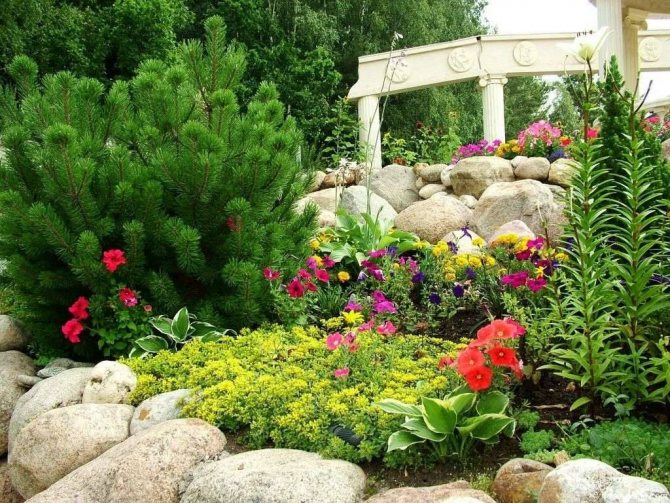
In this style, special attention is paid to smell. Choose fragrant, fragrant plants. In the garden near the bathhouse there are many benches, next to which there are various plants. The main characteristics of the decor are peace and relaxation.
Cottage
This is a rural destination. A lot of stones are used for decoration. There is no place for strict shapes and lines. Paths made of stones can be decorated on both sides with low plants. Place natural wood furniture in the garden.
When choosing flowers for your flower beds, choose options with colorful buds. If you want to complement the style with trees, various fruit varieties are ideal: pear, apple, cherry. Climbing plants will fit perfectly.
Japanese
The main characteristics of this direction are lightness and simplicity. Perennial plants are used in harmony with the abundance of stones. Red shrubs are used as elements. The rest of the color scheme consists of green and gray.
Russian village
An ideal style for arranging a garden with a Russian bathhouse. Flower beds are made up of flowers in pots (an old bucket or watering can serve as a container). Flowers of various varieties and colors are planted in flower beds. The composition is complemented with stacks of firewood.
For interesting tips on flower bed design, watch the following video.
Regular
This option is especially popular with the stronger sex. The object itself is in the center of the composition. The bathhouse should have laconic and strict forms. Plants are placed in a checkerboard pattern depending on the structure. In between, you can equip a seating area.
Make a choice in favor of oriental flora. They grow slowly, so there is no need to trim them. Give the bushes a strict shape. This design technique is classic. The garden will be decorated with a small “living” labyrinth.
Cottage
This is a rural destination. A lot of stones are used for decoration. There is no place for strict shapes and lines. Paths made of stones can be decorated on both sides with low plants. Place natural wood furniture in the garden.
When choosing flowers for your flower beds, choose options with colorful buds. If you want to complement the style with trees, various fruit varieties are ideal: pear, apple, cherry. Climbing plants will fit perfectly.
What plants should I plant?
Of course, when planning a bathhouse (finished or not), its surroundings also play a huge role: what plants to plant around is not as simple a question as it might seem. Naturally, the idea of improving the bathhouse should fit into the existing design on the site, but by considering the problem from a practical point of view, you can find several successful solutions. Among the trees, depending on personal preferences, you can plant birches for fresh bath brooms, and linden trees for excellent bath teas. However, it is very important to ensure that large trees do not block the sunlight entering the small windows of the bathhouse. In addition, many conifers, such as fir, cypress, and so on, are very practical and decorative. Junipers are especially successful when planted around a bathhouse, whose branches can not only decorate your bathhouse, but also purify the air around it. Solitaires such as various lilacs, spray roses or thunberg barberries can also revive a bathed area. But the absolute favorites for planting near the bathhouse are fragrant herbs: thyme, St. John's wort, basil, mint, rosemary, oregano... Chosen to your taste, all of them will be an excellent help for preparing bathhouse teas and infusions, making a trip to the bathhouse an excellent therapeutic relaxation after a long work day. day.
You can purchase a high-quality ready-made bathhouse with delivery and installation at the Universal-Stroy plant. Rosselkhozpitnik specialists will help with the selection, delivery and planting of plants around your bathhouse.

